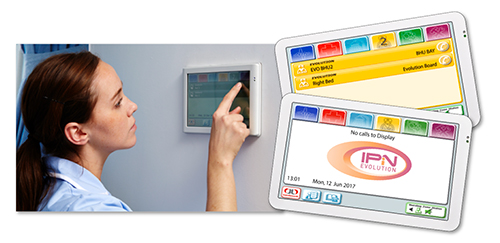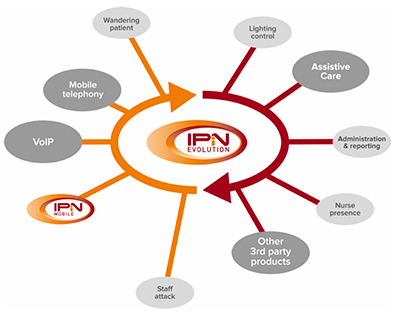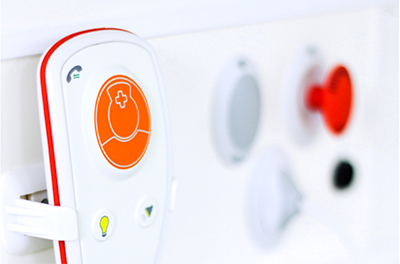We are all aware about the speed of change in technology. We experience it every day in all parts of our life. This change also affects the systems and ways in which we work. Nurse call systems have not been immune to these changes and over the past 10 years have experienced the same rapid pace of development we see across all technologies.
Changes create challenges, but also opportunities, with new technology providing the opportunity to deliver improved communication between patient and clinical staff as well as having a considerable positive impact on operational efficiencies. However, one of the problems associated with rapid change is that systems can quickly become outdated and unable to utilise the latest technology advancements. Therefore, many opportunities cannot be fully embraced. Ideally, the healthcare solutions that are being delivered today should be both adaptable and flexible enough to enable these technological advances to be incorporated, whether the advancements come a year down the line or many years into the future.
For nurse call systems the solution is already available. Fully-IP systems deliver IP capability to the bed. This results in the required infrastructure being ready in place to allow expansion and adaption of bedhead solutions, through its ability to integrate the new advancements delivered by new technology. The Fully-IP system allows for the largest degree of flexibility as the system can grow, change, adapt and expand with the hospital, removing the fear and problems associated with systems becoming outdated.
For a quick reference, IP stands for ‘Internet Protocol’ and is the primary network protocol used on the internet. It organises data into ‘packets’, which include both the data that needs to be communicated and a header, which provides vital information about the data, including its source and destination.

Fully-IP infrastructure results in a dynamic hospital infrastructure that can easily change with needs of patient, practitioners, and managers
Futureproofing
Also commonly used as a communications protocol in a private network; IP is usually found alongside Transmission Control Protocol (TCP) and we all rely on TCP/IP technology every day of our lives, not only for computing and internet communications, but also for telecommunications, broadcasting and transport.
The capabilities of each system can vary drastically and the level of futureproofing is therefore affected. Firstly, it is important to understand the difference between a Fully-IP-based system and a system that is simply built on an IP ‘backbone’, as the implications for system integration are significant. Fully-IP systems provide IP infrastructure to the bedhead, whereas an IP-based system utilises an IP Network, but does not bring the IP infrastructure down to each bedside.
Mission critical
IP-based nurse call systems have been around for nearly 10 years now. In fact, the first IP nurse call system (IPiN, a Fully-IP system) was installed by Wandsworth Healthcare in 2008 at Birmingham Queen Elizabeth Hospital. Many systems are now IP based, meaning they utilise the Internet Protocol for transfer of mission-critical healthcare communications; and IP is regarded as the most-reliable and cost-effective option.
Importantly, by using an IP Platform, you open up a topology that the majority of other services are using, including, typically, a hospital IT department, fire alarm system, and building management system. Therefore, all are working to the standards set by the Ethernet networking protocol.
The benefits
The core benefits of a Fully-IP system can simply be put as integration and flexibility, which, when combined, provide a complete futureproof solution. A ‘fully IP to the bed’ system enables new technology, offered by either the nurse call system provider or any third party, to be easily integrated. The result is a dynamic hospital infrastructure that can easily change with needs of patient, practitioners, and managers.
With a Fully-IP system, integration with other IP-based technology is relatively straightforward, allowing interconnectivity of the nurse call with lighting control, door security, wandering patient and assistive care systems, to name a few. The possibilities for integration with third-party systems, not only ensure a flexible, scalable solution, but also introduce the ability to deliver higher levels of patient care.

Wandsworth’s IPiN Evolution system is fully scalable
Flexibility
In any hospital, it is inevitable that needs will be in a constant state of flux in response to changes in patient demographics, hospital resources, NHS policy, or developments in medical science. As a consequence, space may need to be reallocated, perhaps, for example, involving the subdivision of a ward or the expansion of a specialist department.
While these changes would potentially require significant disruption of a ward, a Fully-IP system could be reconfigured remotely, enabling the hospital to reallocate beds to different wards and different nurses station without having to make physical changes to cabling infrastructure. Indeed, the latest technology for healthcare is based on a TCP/IP platform, which is why the integration possibilities for a Fully-IP based nurse call system are so diverse.
It could be viewed that the use of TCP/IP for the core nurse call system, as well as the system backbone, provides an over-specified solution, when, in fact, it simply provides a futureproofed approach to designing a system that will enhance the longevity of the nurse call and provide more effectively for potential technology upgrades.
While integration of additional technologies is possible with IP-based nurse call systems, only a system that is Fully IP can provide one low-cost interface for all additional integrated systems, rather than requiring multiple protocols to be supported to provide for each additional feature. This means that, over time, it will be more cost-effective, establishing the high-quality foundations of a system that can be built on as needs dictate.
Data collection
Fully-IP systems enable far-more-extensive call reporting than IP-based call systems due to the complex way IP-based systems log data. A Fully-IP system logs and stores data on a centralised basis using its own dedicated network behind a firewall. The zoned nature of an IP backbone system means that data is collected on a zone-by-zone basis.
While the data is accurate; it is fragmented, making collation and interrogation of the data for analysis and reporting more complex and time consuming. As the requirement for accurate, real-time data becomes an increasingly-important tool for forecasting clinical demand, meeting targets for clinical care, and protecting trusts from possible litigation; the ability to log and analyse data centrally is a clear benefit of Fully-IP systems.
The system ensures that data is collected from the entire site and can then be accessed from any terminal, which reduces the administrative burden. It also ensures that any maintenance issues are identified quickly, which, in turn, ensures that they can be resolved quickly too.
Maintenance
Fully-IP systems can be monitored by the maintenance department or remotely via an ADSL link and firewall, which allows fault identification and rectification.
This not only offers potentially-significant reductions in the preventative maintenance regime; but also reduces the risk of system failure, the potential for downtime, plus the time and cost of repairs.
Patient comfort
The Fully IP system also provides the ability to broadcast the large number of available digital radio stations. This improves the entertainment options available to the patient and helps provide a better and more-enjoyable hospital stay.
Pressures
With a constant downward pressure on budgets, while simultaneously expecting constant improvement to the patient experience, trusts are in a difficult position. But, by utilising new technological advances, both objectives can be met. It is worth noting that to enable implementation to be as cost effective and efficient as possible, there must be a plan put in place to integrate the new technological developments.

The benefits of Fully-IP systems include comprehensive site-wide administration, reporting and alerting capabilities; much-easier and faster transfer of calls between staff; and integration with third-party communication systems
IPiN Evolution
Wandsworth Healthcare IPiN system specialist, Terry Boarer, explained the benefits of Wandsworth’s Fully’IP system – IPiN Evolution. He said: “The benefits of Fully-IP systems, and in particular our IPiN Evolution system, include comprehensive site-wide administration, reporting and alerting capabilities; much-easier and faster transfer of calls between staff; integration with third-party communication systems – including mobile phones, VOiP devices and many other third-party panic systems; and the ability to connect many other hospital devices, for instance lighting and access controls.
“A Fully-IP system is also fully scaleable, meaning that from a simple 30-bed ward, all the way to a whole hospital site of 1,200 beds; the deployment and management of the system is reliable, effective, and straightforward. He said its IPiN system was specially developed to follow the demands of the acute healthcare sector, adding: “We wanted to look into the future and understand what technologies would be arriving and how acute care would evolve. This was a difficult task, but we figured if our system was adaptable and flexible it didn’t matter what innovations came along as the system could adapt and integrate them.”
Future innovation
IPiN Evolution is the latest IPiN nurse call solution providing newly-developed, fully-tested and proven hardware and software to provide an enhanced, futureproof solution while maintaining use of the IP communications network.
IPiN Evolution can be added, removed, or rerouted as needs dictate, delivering the flexible network required. It has a number of tools and functions that can ensure effective maintenance and management of the IPiN nurse call system. These include the ability for authorised staff to make alterations to data, including room names and reporting of faults on the network instantly to a central point or a designated mobile device.
With the continual focus on reporting and use of data to legally protect trusts from litigation; IPiN Evolution has been developed to make reporting and administration simple and efficient across the network. Any event that happens on the IPiN network is logged and stored locally. These events are displayed on the user-friendly dashboard and admin toolkit and can be accessed using password authentication from any trusted device.
